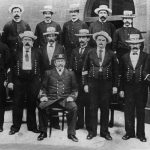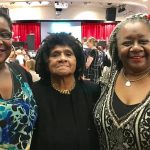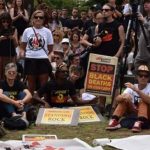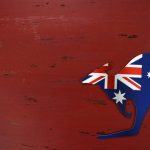The Frontier Violence Perpetrated by the NSW Mounted Police
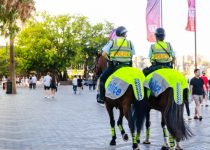
Most Sydneysiders would have at one time or another seen members of the NSW Mounted Police out on patrol. Often these officers – who for the most part work in pairs – can be seen riding their horses down Surry Hills streets or patrolling the outskirts of public demonstrations.
Operating out of the Bourke Street Police Complex in Redfern, the NSW Mounted Police is the oldest continuous mounted police unit in the world. These days, it’s comprised of around 36 officers and 38 horses.
Over recent years, the NSW Mounted Police has been causing controversy as officers refuse to clean up the waste their horses deposit on the city streets. State laws don’t require horse owners to pick up after their animals, as they’re classed as vehicles.
However, what most locals don’t realise is that the NSW Mounted Police – which were founded on 7 September 1825 by Governor Thomas Brisbane – was originally a paramilitary force charged with quelling Aboriginal resistance to the British colonising forces.
The forgotten wars
Frontier conflicts broke out on this continent just after the British began their armed takeover of Aboriginal nations’ lands in 1788. During the 1790s, wars were fought along the rivers now known as the Hawkesbury and the Nepean.
The Bathurst War was fought between the Wiradjuri nation and British forces. In May 1824, the local people carried out a series of raids against the invaders, who then brought in reinforcements. The conflict came to an end after the British carried out a decimation of the local people in September.
Following the Bathurst conflict, it was decided that a mounted infantry was necessary in NSW. And this was to be recruited from British troops present in the colony. The first detachment was stationed at Bathurst and the second in Wallis Plains: the region now known as Maitland.
A key function of the Wallis Plains division of the NSW Mounted Police was to combat the local Aboriginal resistance in the newly colonised Hunter Valley region. In relation to this function, the police carried out raids on Indigenous camps and executed captured local detainees.
By 1829, the NSW Mounted Police was under the command of Lieutenant Colonel Kenneth Snodgrass. And it had expanded to contain two new detachments: one in Goulburn and the other in Sydney, which was stationed at Belmore Barracks, located at the present site of Central station.
Slaughterhouse Creek
As NSW acting governor, Colonel Snodgrass appointed the notorious Major James Nunn commandant of the NSW Mounted Police. Snodgrass ordered Nunn to go out to the Liverpool Plains and deal with the Gamilaraay people’s resistance to British occupation.
In late 1837, Major Nunn led the NSW Mounted Police in a two month sweeping operation along the Gwydir and Namoi Rivers. The operation climaxed on 26 January 1838 with the Waterloo Creek massacre, which saw the wholesale slaughter of Gamilaraay people.
Nunn and his officers continued on with their murderous rampage for a further three days after the slaughter, killing every Aboriginal person they came across. During the course of the operation, its believe that up to 300 Indigenous people were killed by the police on horseback.
A belated inquiry into the murders was carried out by the colonial government, but there were no prosecutions and the matter was eventually dropped.
Cold-blooded murder
The inquiry into the massacre carried out by the NSW Mounted Police was delayed as it was overshadowed by the public attention given to another blatant slaughter carried out against Indigenous people at Myall Creek station.
In mid-1838, a group of around 50 Gamilaraay people were camped out at the station, as they’d been invited to do so by a local stockman. On 10 June, a group of ten stockmen not associated with the station arrived at the camp, which was populated by men, women and children.
These men then set about tying up the Gamilaraay people and leading them away from their camp. The Europeans then hacked the Aboriginal people to death. The stockmen returned to the scene of the crime two days later to burn the bodies and kill the local people they missed the first time.
The Myall Creek massacre didn’t gain notoriety for the sheer brutality of the incident, but rather, it drew public attention because of what happened to the white perpetrators. The atrocity was reported to police in Sydney three weeks later and the governor order an investigation.
The ten killers were eventually captured, marched into Sydney and put on trial. However, the defendants had the widespread support of the community and given the thin body of evidence – as there were no witnesses or bodies of the deceased – the men were acquitted.
But, a second trial held ten days later that focused on the murder of just one child, saw the jury find seven of the stockmen guilty. The killers were hung in December that year.
Their duty as police
Somewhat ironically, it was the NSW Mounted Police that went out and apprehended the Myall Creek murders. This served to confirm police neutrality in the mind of the public, despite the fact that these police on horseback had been murdering Indigenous people themselves.
From its inception, the NSW Mounted Police operated for the most part in the central part of the colony. And the colonial government created the NSW Native Mounted Police to deal with the northern regions in the expanding colony in 1848.
The NSW Native Mounted Police was a force consisting of Aboriginal troops commanded by European officers. It was known for carrying out widespread extrajudicial shootings of Aboriginal people under the guise of dispersal.
And with the growth of the native police, the NSW Mounted Police ceased its paramilitary function and its frontier duty of repressing the Aboriginal resistance. In 1850, the force took on the more civilian role that it still carries on today.
A sign of the times
In September last year, the NSW Mounted Police announced it would no longer be holding its annual open day due to security concerns regarding its officers and horses. In a Facebook post the unit announced that the public day was no longer feasible “due to the current political climate.”
A NSW police spokesperson said at the time that the sheer volume of people the event drew made it impossible to screen them all. Although, pre-booked tours of the Redfern headquarters are still available for those wanting to visit the facility.




